Nvidia Announces New Drive Platforms With Orin and Ampere
by Andrei Frumusanu on May 14, 2020 6:01 AM EST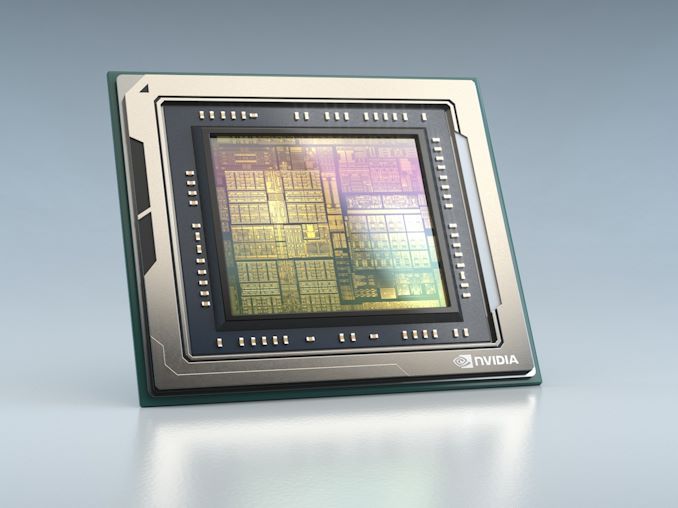
Nvidia’s Orin SoC chipset had been on Nvidia’s roadmaps for over 2 years now, and last December we got the first new details of the new automotive oriented silicon chip, revealing characteristics such as it containing 12 core cores of Arm’s newest “Hercules” microarchitecture (A77 successor).
Orin is meant to be the heart of Nvidia’s upcoming DRIVE automotive platforms, and today the company is ready to reveal a few more important details such as the scalability of the SoC and the different DRIVE solutions.
| NVIDIA ARM SoC Specification Comparison | |||||
| Orin | Xavier | Parker | |||
| CPU Cores | 12x Arm "Hercules" | 8x NVIDIA Custom ARM "Carmel" | 2x NVIDIA Denver + 4x Arm Cortex-A57 |
||
| GPU Cores | Ampere iGPU (?? cores) |
Xavier Volta iGPU (512 CUDA Cores) |
Parker Pascal iGPU (256 CUDA Cores) |
||
| INT8 DL TOPS | 200 TOPS | 30 TOPS | N/A | ||
| FP32 TFLOPS | ? | 1.3 TFLOPs | 0.7 TFLOPs | ||
| Manufacturing Process | 7nm? | TSMC 12nm FFN | TSMC 16nm FinFET | ||
| TDP | ~5-45W | 30W | 15W | ||
Specifications wise, the newest revelations about the Orin design is that it features Nvidia’s newest Ampere architecture as its integrated GPU. Generally, this shouldn’t come as too much of a surprise given the timeline of the SoC.
Nvidia still doesn’t disclose exact configurations of the GPU, but if the mock-up die-shot of the chip is anything to go by, we’ll be seeing a 32SM configuration – which fits nicely with the claimed peak 200 INT8 DL TOPs that Nvidia claims for the chip.
Manufacturing wise, we again don’t have exact details, but we’re assuming a 7nm-class process node. One interesting disclosure today however was the fact that Orin is supposed to scale from 5W to up to 45W platforms, which is a very wide range.
The 5W platforms claims up to TOPs inference performance, and it’s meant for ADAS solutions as depicted above, designed to fit behind a windshield. Nvidia being able to scale Orin down to a 5W TDP is extremely interesting, but undoubtedly will have the chip disable much of its capabilities, or clock down to very low frequencies to achieve this power envelope.
The chip is also offered in an L2+ automotive solution, enabling the full power of Orin at up to 45W. Here we see the full 200TOPs of inference performance that Nvidia had disclosed back in November. We're seeing 8 DRAM chips on the depicted board, likely pointing out to a 128-bit memory controller setup.
Finally, Nvidia is bringing out the biggest guns in its DRIVE line-up for the robotaxi solution, an L5 automotive solution is meant to power fully autonomous robotaxi vehicles.
The platform here has two Orin SoCs paired with two Ampere GPUs for total power envelope of 800W and up to 2000 TOPs of performance. The GPU here, judging by its size and form-factor with HBM memory is seemingly the newest GA100 Ampere GPU. Nvidia disclosed that this GPU alone scales up to 400W in the SXM form-factor. Clocking two of these slightly lower and adding two 45W Orin SoCs gets us to the massive 800W power envelope.



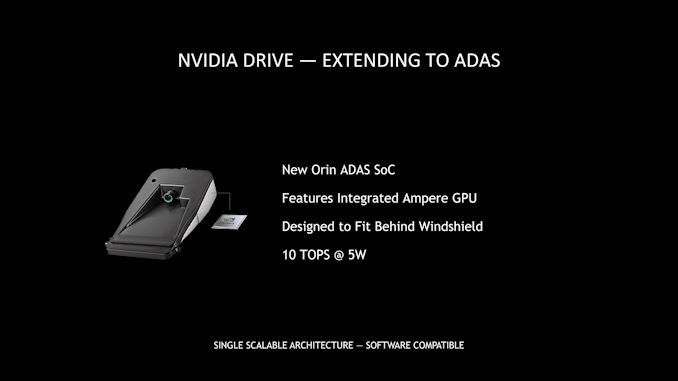
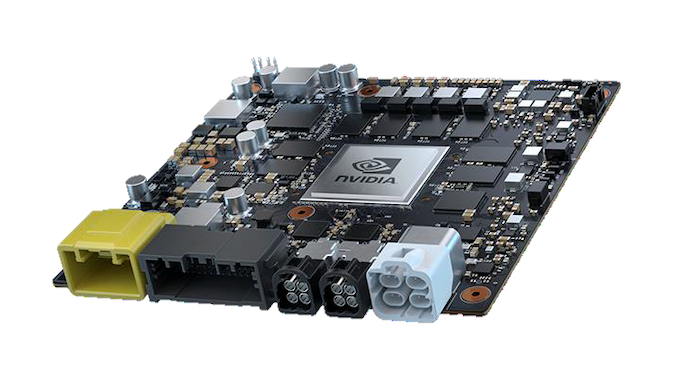
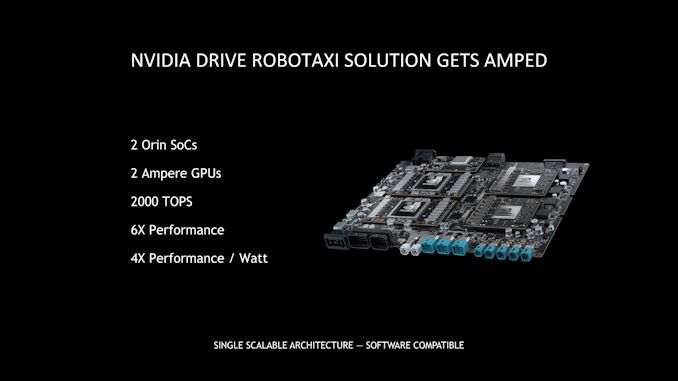
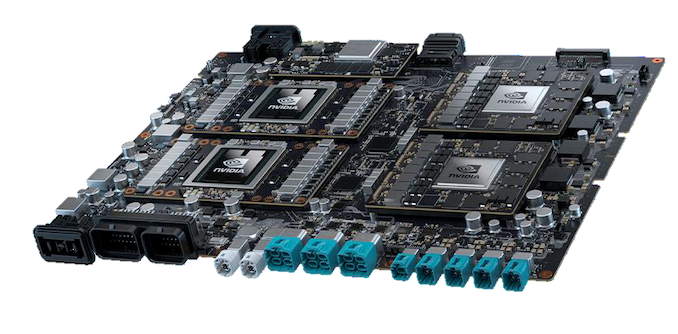








32 Comments
View All Comments
nandnandnand - Thursday, May 14, 2020 - link
You mixed up Qualcomm with Samsung.Using some version of RDNA could make developing for Nintendo easier, since XSX/PS5 will be using RDNA2, maybe with some customizations.
Spunjji - Friday, May 15, 2020 - link
AMD are definitely already ahead of where the current switch console is with its Maxwell GPU; if RDNA 2 lives up to AMD's goals then it will close the gap further.Nintendo never go for the latest and greatest hardware in their devices, so it doesn't need to beat whatever Nvidia might offer (if they even offer anything - they haven't made a mobile-focused Tegra platform for a while).
That said, I'd be surprised to see them jump onto a Samsung/AMD platform unless it had already been out for a year or two.
brucethemoose - Thursday, May 14, 2020 - link
15W is pretty toasty for a handheld, 45W would be more like a laptop.Alistair - Thursday, May 14, 2020 - link
The Switch has a fan and works fine with 15W.brucethemoose - Thursday, May 14, 2020 - link
Also, Orin is clearly focused on AI performance, which Nintendo doesn't really need.Alistair - Thursday, May 14, 2020 - link
You just remove the parts you don't need, and make a new mask for the Switch without it. I want the CPU and GPU and memory parts mainly of course.Spunjji - Friday, May 15, 2020 - link
Nvidia aren't renowned for being a good company to work with when it comes to that sort of customisation, though. That's why AMD ended up snapping up all the home consoles.CiccioB - Thursday, May 21, 2020 - link
It's not a question of customization, it is a question of costs.AMD decided to go to provide APUs for the consoles gaining a piece of cheese for that work.
Nvidia which didn't had idling engineers but lots of plans for the datacenter market preferred to invest its brains into something which would bring back much more value.
In fact AMD OEM market, which includes EPYC market beside console SoC, is equal to nvidia OEM market, which includes Nintendo SoC, and it is in total less than 10% than Nvidia total revenue.
katherinedmathis50 - Friday, May 29, 2020 - link
I’ve made $66,000 so far this year w0rking 0nline and I’m a full time student. I’m using an 0nline business opportunity I heard about and I’ve made such great m0ney. It’s really user friendly and I’m just so happy that I found out about it… www.iⅭash68.ⅭOⅯeastcoast_pete - Thursday, May 14, 2020 - link
If one or both Ampere GPUs could also be used for gaming, some of us might decamp to the self-driving car for that. Would give "mobile gaming" a new meaning (:It can drive itself, but can it run Crysis?